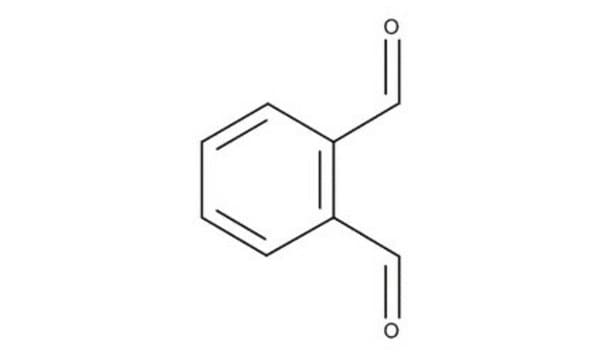1.11452
Phthaldialdehyd
for fluorometry
Synonym(e):
Phthaldialdehyd, OPA
About This Item
Empfohlene Produkte
Qualitätsniveau
Form
solid
Selbstzündungstemp.
480 °C
Wirksamkeit
178 mg/kg LD50, oral (Rat)
>2000 mg/kg LD50, skin (Rat)
pH-Wert
7 (20 °C, 53 g/L in H2O)
bp
83-84 °C/1 hPa
mp (Schmelzpunkt)
52-58 °C
Übergangstemp.
flash point 132 °C
Löslichkeit
53 g/L
Dichte
1.13 g/cm3 at 20 °C
Schüttdichte
530 kg/m3
Lagertemp.
2-30°C
InChI
1S/C8H6O2/c9-5-7-3-1-2-4-8(7)6-10/h1-6H
InChIKey
ZWLUXSQADUDCSB-UHFFFAOYSA-N
Anwendung
- Combined techniques for revealing the mechanism beneath the inhibition effects of pectin on gluten digestibility using static in vitro gastro-duodenal protocols.: This study uses a combination of techniques to explore how pectin affects gluten digestibility, providing insights into the interaction of phthaldialdehyde derivatives with gluten proteins (Lin et al., 2024).
- Analysis of Gizzerosine in Foodstuffs by HPLC Involving Pre-column Derivatization with o-Phthaldialdehyde.: This research develops a method using HPLC with pre-column derivatization involving phthaldialdehyde to analyze gizzerosine in foodstuffs, demonstrating the compound′s utility in food safety studies (Li and Wu, 2024).
- Comprehensive studies on the development of HPLC-MS/MS and HPLC-FL based methods for routine determination of homocysteine thiolactone in human urine.: This study develops and validates methods using phthaldialdehyde derivatives for the determination of homocysteine thiolactone in human urine, contributing to clinical diagnostics and biochemical research (Piechocka and Głowacki, 2024).
- Smart-detection approach for protein residues to evaluate the cleaning efficacy of reusable medical devices.: Utilizing phthaldialdehyde for protein residue detection, this study provides a smart detection approach to improve the cleaning efficacy of medical devices, enhancing patient safety (Ouirungroj et al., 2024).
- One-pot sample preparation procedure for the determination of protein N-linked homocysteine by HPLC-FLD based method.: This research presents a novel one-pot sample preparation method using phthaldialdehyde for determining protein N-linked homocysteine, advancing analytical techniques in protein chemistry (Piechocka and Głowacki, 2023).
Hinweis zur Analyse
Identität (IR): entspricht
Schmelzpunkt: 54–58 °C
Fluoreszenz (340 nm, 0,8 g/l, Ethanol, als Chinin): ≤ 2 ppb
Phthalsäure (DC): ≤ 0,5 %
Stickstoffverbindungen (als N): ≤ 0,05 %
Signalwort
Danger
Gefahreneinstufungen
Acute Tox. 3 Oral - Aquatic Acute 1 - Aquatic Chronic 1 - Eye Dam. 1 - Skin Corr. 1B - Skin Sens. 1 - STOT SE 3
Zielorgane
Respiratory system
Lagerklassenschlüssel
6.1A - Combustible, acute toxic Cat. 1 and 2 / very toxic hazardous materials
WGK
WGK 3
Flammpunkt (°F)
269.6 °F - closed cup
Flammpunkt (°C)
132 °C - closed cup
Analysenzertifikate (COA)
Suchen Sie nach Analysenzertifikate (COA), indem Sie die Lot-/Chargennummer des Produkts eingeben. Lot- und Chargennummern sind auf dem Produktetikett hinter den Wörtern ‘Lot’ oder ‘Batch’ (Lot oder Charge) zu finden.
Besitzen Sie dieses Produkt bereits?
In der Dokumentenbibliothek finden Sie die Dokumentation zu den Produkten, die Sie kürzlich erworben haben.
Kunden haben sich ebenfalls angesehen
Unser Team von Wissenschaftlern verfügt über Erfahrung in allen Forschungsbereichen einschließlich Life Science, Materialwissenschaften, chemischer Synthese, Chromatographie, Analytik und vielen mehr..
Setzen Sie sich mit dem technischen Dienst in Verbindung.








